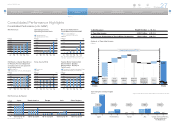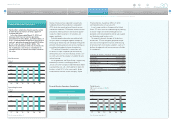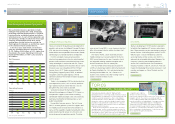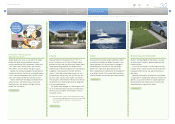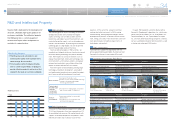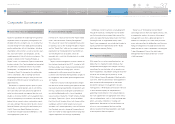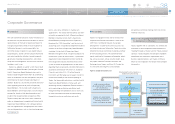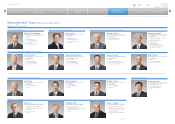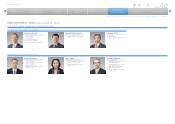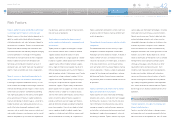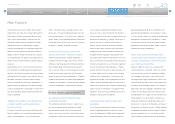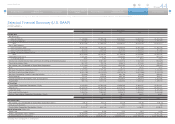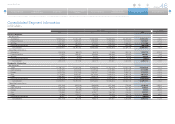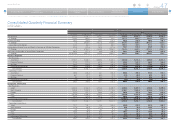Toyota 2014 Annual Report Download - page 37
Download and view the complete annual report
Please find page 37 of the 2014 Toyota annual report below. You can navigate through the pages in the report by either clicking on the pages listed below, or by using the keyword search tool below to find specific information within the annual report.
ANNUAL REPORT 2014
President’s MessagePresident’s Message
Overview of
Four Business Units
Overview of
Four Business Units
Special FeatureSpecial Feature
Review of OperationsReview of Operations
Consolidated Performance
Highlights
Consolidated Performance
Highlights
Management and
Corporate Information
Management and
Corporate Information
Investor InformationInvestor Information
Financial SectionFinancial Section
Page 37
NextPrev
ContentsSearchPrint
Corporate Governance
N Corporate Governance System
In March 2011, Toyota announced the “Toyota Global
Vision” and commenced “Visionary Management.”
This is based on values that have guided Toyota since
its founding, such as the “Guiding Principles at Toyota”
and the “Toyota Way,” which aim to exceed customer
expectations by the development of ever-better cars
and enriching the lives of societies, and to be
rewarded with a smile that ultimately leads to a stable
base of business.
Toyota’s current management structure is based on
the structure introduced in April 2011. In order to fulfill
the Toyota Global Vision, Toyota reduced the Board of
Directors and decision-making layers, and has
endeavored to swiftly communicate the views of
customers and information from operations on-ground
to management and facilitate rapid management deci-
sion making.
In April 2013, Toyota made organizational changes
with the aim of further increasing the speed of decision
making by clarifying responsibilities for operations and
earnings, specifically by dividing the automotive busi-
ness into the following four units—Lexus International
(Lexus business); Toyota No. 1 (North America, Europe
and Japan); Toyota No. 2 (China, Asia & the Middle
East, East Asia & Oceania; Africa, Latin America & the
Caribbean); and Unit Center (engine, transmission,
and other “unit”-related operations)—and an Executive
Vice President was put in charge of the operations of
each unit in order to realize organizational change that
supports operations and earnings responsibility.
N Toyota’s Basic Policy on Corporate Governance
Toyota has positioned the stable long-term growth of
corporate value as a top-priority management issue.
We believe that in carrying this out, it is essential that
we achieve long-term and stable growth by building
positive relationships with all stakeholders, including
shareholders and customers as well as business part-
ners, local communities, and employees, and by
supplying products that will satisfy our customers. This
position is reflected in the “Guiding Principles at
Toyota,” which is a statement of Toyota’s fundamental
business policies. Also, Toyota adopted and presented
the CSR Policy “Contribution towards Sustainable
Development,” an interpretation of the “Guiding
Principles at Toyota” that organizes the relationships
with its stakeholders. We are working to enhance
corporate governance through a variety of measures
designed to further increase our competitiveness as a
global company.
We believe it is important to put in place a system
that enables customer opinions and on-site informa-
tion to be swiftly communicated to management in
order to make a prompt management decision, and
enables us to review whether such management deci-
sions are accepted by our customers and society. We
believe that our current system, involving the supervi-
sion and auditing of the execution of business by our
Board of Directors (including Outside Directors) and
Audit & Supervisory Board Members (including
Outside Audit & Supervisory Board Members), is the
most appropriate system for us.
Additionally, in order to achieve sustainable growth
through the continuous development of even-better
cars that exceed customer expectations around the
world, and realize the Toyota Global Vision, the TNGA
Planning Division, an organization directly under
Toyota’s top management, was established in order to
rapidly promote the implementation of the “Toyota
New Global Architecture (TNGA).”
N Management Transparency
With respect to our system regarding directors, we
believe that it is important to elect individuals that
comprehend and engage in our strengths, including
commitment to manufacturing, with an emphasis on
front-line operations and problem solving based on the
actual on-site situation (genchi genbutsu). At the
109th Ordinary General Shareholders’ Meeting held in
June 2013, three Outside Directors were appointed in
order to further reflect the opinions of those from
outside the Company in management’s decision-
making process. While Toyota currently does not have
its own standard or policy on independence in
appointing Outside Directors, the Company believes
that such appointments are appropriate since various
rules on independence, such as stock exchange regu-
lations, are used as references in making such
appointments. We believe our Outside Directors will
advise us in our management decision-making
process based on their broad experience and insight
in their respective fields of expertise.
Toyota has an “International Advisory Board”
consisting of advisors from each region overseas, and,
as appropriate, receives advice on a wide range of
management issues from a global perspective. In
addition, the Company has a wide variety of confer-
ences and committees for deliberations and the moni-
toring of management and corporate activities that
reflect the views of various stakeholders, including the
“Labor-Management Council, the Joint Labor-
Management Round Table Conference,” and the
“CSR Committee.”
R&D and Intellectual Property Corporate Philosophy Corporate Governance [1 of 2] Management Team Risk Factors


